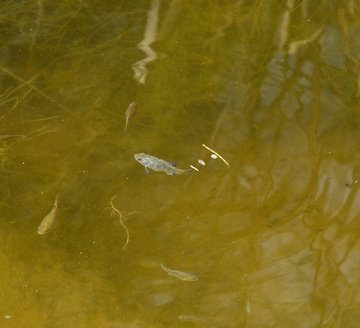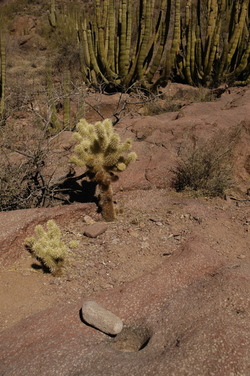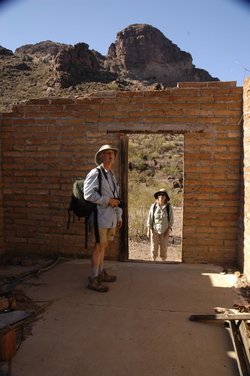The Endangered Visitor
Organ Pipe Cactus National Monument has changed lately and not for the better, I’m sorry to say. Continuing border problems and the threat of violence from drug-runners has caused the park service to shut down all back-country hiking trails and all the border roads in the park. This effectively eliminates the majority of access to the park’s many subtle delights. Old mines, historic ranch sites, even the tiny habitat of the endangered Quitobaquito desert pupfish – all are off limits now. Now it seems that visitors to the park have joined the desert pupfish as an "endangered" species needing protection.

The endangered Desert Pupfish. Note the male fish is blue.
A year ago the border was a problem too, but only a small portion of the park was closed at that time. The most recent closures have changed the essence of the experience at Organ Pipe. It is still a peaceful and beautiful place, but the tension of border problems is an ever-present cloud. The rangers have to spend too much of their time explaining why you shouldn’t explore parts of the park – something that must really frustrate them. The Visitor Center is named for a ranger who was shot to death by criminals who crossed the border.
A short distance from the campground you can find large blue flags on a tall pole, indicating one of several humanitarian water stations. These are put in the park to aid the everyday “UDAs” (Undocumented Aliens) who attempt to hike 80 or more miles through brutal desert conditions with completely inadequate preparation. Many of them have no idea what conditions they will face, when they cross the fence. Once they’ve realized their mistake, rather than dying in the desert they can get water and wait for help (which will include deportation).
Fear is now a factor in the park. The park visitors, the rangers, the border control agents, and the UDAs all feel it. Hiking in the park in years past we would have looked for rattlesnakes, gila monsters, cactus wrens, or kangaroo rats. Now, will you see any of those or will you be too busy looking for an armed drug runner, a desperate family without enough water, or a giant pile of trash left by border crossers long since departed?
I don’t mean to pick on Organ Pipe Cactus National Monument. It’s still a wonderful park and it doesn’t deserve the problems it faces. We’ll come again and enjoy it again. But the huge changes we’ve seen here in just one year reminds me that all parks are subject to change as a result of environmental, political, climatological, or even geographical changes.
When you visit one, try to experience as fully as your time allows. Next time you visit, things may have changed, especially in border parks. During our first visit to Big Bend National Park, we were able to freely cross the Rio Grande to have dinner in Boquillas Mexico. Now that’s illegal. In Hawaii Volcanoes National Park, lava flows can ebb to barely anything, so if the lava is visible, it’s worth staying until dusk to see it!
One year I planned to visit Cabrillo National Monument during a business trip to San Diego, but my free day was September 12, 2001, and the monument – being close to a naval base – was off-limits for a few panicky days. It was four years before I got another chance at it.
In Sabino Canyon (part of the Catalina National Forest in Tucson), floods during the last monsoon season wiped out trails that we could have hiked the previous year, if we’d taken the time. We’ve accumulated dozens of other examples, too. The point is that even in national parks, where the goal is preservation for future generations, nothing is static. Seize the day!
The good news is that Organ Pipe is not heavily visited, so seekers of peace and quiet can still find it here. The RV campground in Organ Pipe Cactus National Monument has no hookups. The park also takes no reservations, cell phone coverage is marginal, and the park is far from population centers and services. These factors keep visitation to the campground down.
Last year we had to leave the park earlier than we wanted because the furnace chewed up our power at night and even running the generator for the maximum four hours allotted each day wasn’t enough to keep up. This year we have solar panels, like most of the other residents here. Solar is ideal for places like Organ Pipe because it silently recharges the batteries all day, not just during the posted generator hours, and there’s plenty of sunshine here. We have had more than enough power to fully recharge the batteries every day.
Next to us are Richard and Norma, who coincidentally I met last year at the International Rally in Salem OR. Richard is a woodcarver, and his trailer has several delicate hummingbird carvings hanging from it. He carved one just for Emma, too, from a single piece of wood. It’s a beautiful thing, and just the right size and weight to be a good full-timer’s souvenir. We’ll find a place in the Airstream to hang it.
Two spaces down are Bert & Janie, and today Ken & Petey showed up in their 1964 Airstream Globe Trotter, so that makes four Airstreams in our immediate area.
Our Google Earth campsite location in Organ Pipe.

A grinding hole, cholla cactus, and organ pipe cactus
Today Bert recruited me for a hike by Alamo Canyon. Janie came along, but Eleanor stayed back because Emma was still sleeping. The hike started about 10 miles north of the campground (and three miles down a bumpy dirt road), following a perennial stream to an old one-room ranchhouse and corral. Along the dry streambed there are ancient Native American grinding holes in the bedrock, fifteen by our count. These are quite possibly thousands of years old, and were used to grind up mesquite seeds and other gatherings. We’ve encountered these in Big Bend National Park and other places, but they always are awe-inspiring and make me think about how the people before us managed to live here.

Bert & Janie explore an abandoned one-room ranch house, Alamo Canyon
This evening Bert went back out to Alamo Canyon to shoot a particular night scene. He wanted to capture saguaro cactus against the Ajo Mountains with the stars creating circular trails overhead. This picture requires a tripod, very clear skies, a view of the Polaris (the north star), a cable release, and a camera that has a “Bulb” setting that holds the shutter open indefinitely. He came back successful, with a gorgeous 15-minute exposure that appears on his blog. I wish I’d tried it too, but we hung back to attend the 7 p.m. ranger talk about Organ Pipe’s sister park in Mexico, called Pincate.
Tomorrow we will disperse. Ken & Petey will follow us across the border to Puerto Peñasco, and Bert & Janie will begin the long trek back to their home in Montana. They’ve been on the road for nine months, ever since we saw them at their home last July. It’s time for a break for them. I hope they’ll be on the road again this fall so we can have more hiking and bicycling trips together.